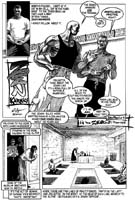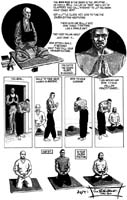Gateway Journal |
Summer 1998-Journal of The Engaged Zen Foundation-Volume 1, Number 4 |
Peace Activist |
by Jarvis MastersDeath Row, San QuentinWhen I awoke in the early morning to begin my meditation practice, I tried to envision myself as a peace activist in the rough neighborhood of my prison tier. The night before, the once-empty cell adjacent to mine had been filled with the raging of a new inmate. Although his loud voice had filtered into my deep sleep, I refused, as I did every night, to awaken, to lose that very comfortable place that finally made sleeping on a hard concrete prison floor easy. Now, in the light of dawn appearing in the window opposite my cell, I quietly placed my folded blanket on the cold floor. My new neighbor began to scream again. “I kill you ... I kill you all, you damn sons a bitches, if y’all don’t let me out of here!” |
New York Zenby Yogen Donald WiseElmira Correctional Facility, Elmira NYMy name is Yogen Donald Wise. I am a Zen Buddhist practitioner presently incarcerated by the New York State Department of Correctional Services. For me, Buddhism has enabled me to witness the transformation of my personality. Through the practice of zazen (zen meditation) I have been able to see a ray of sunlight in the depths of hell. I am grateful to several volunteer zen teachers operating in the New York prisons, Rev. Yoshin Radin, Rev. Kobutsu Malone, Rev. Saman Sodo and E-Kun Liz Potter. Grazia Ciccio!by Adriano SofriI would like to tell you about a prison guard nicknamed Ciccio (Fatso) in Bergamo Prison, Italy. |
From the Editorby Rev. Kobutsu MaloneVice President, EZFGateway Journal is back! We have not published in over a year due to funding and personal illness. Hopefully with this new issue we will be able to begin regular publication on a more timely basis. The past year has been one of discovery and recovery for me personally. Experiencing Jusan Frankie Parker’s execution in the summer of 1996 was devastating. After Jusan’s death I was left with piles of unpaid bills and prison ministry work neglected in my absence. I was also faced with many uncertainties about what had happened, my part in it and the sense that I had been forced to accept the task of redefining my work. The issue of the death penalty arose through our contact with Jusan and our direct experiences with the death penalty process. For me, there were many times I felt that I stepped beyond the bounds of “engaged” involvement into attachment. I have certainly learned to examine my activity somewhat more carefully. Indeed, learning is an integral facet of “engaged” zen practice. Just because we adopt an “engaged” attitude does not indicate that we have cornered the market on wisdom! For example, the other night, with some friends, I listened to a tape recorded at the news conference held minutes after Jusan’s execution. After the news conference, a radio reporter walked up to me privately and asked me if I felt any personal resentment toward Arkansas Governor Mike Huckabee over Jusan’s execution. My answer was a sharp “no.” The answer defused the reporter’s “angle,” yet now, when I listen to it, that “no” seems to convey tremendous anger. So, for me, such things arise constantly, presenting living koans (instructive puzzles) in my life. At its root, social engagement involves risk, sticking one’s head out, standing naked in the street, so to speak. Engagement requires learning to move through situations with grace, while contributing wisdom and compassion, rather than being attached to, or avoiding, the world in all its manifestations. The past year I became ill to the point that I was hospitalized and finally, after extensive testing, I was diagnosed with fibromyalgia syndrome. The effects of this disease prevented me from working as an engineer, which is what I did to maintain my family and fund many of our EZF activities. I have worked with my hands since I was 17 years old, starting out as a machinist and working my way into engineering and design. The disease has affected my ability to use my hands and perform physical tasks. It has affected me neurologically, such as difficulty with memory and dealing with numbers. My sleep has been severely disrupted often leaving me exhausted. Most significantly, I am unable to sit zazen with the physical stamina I previously had. At first, the sickness was depressing and confusing. I indulged in feeling sorry for myself and slipped into real depression. Doctors have no answers and no cures. I have been given numerous drugs, none of which has been very helpful, and some of which have been downright nasty. There have been times I have just wanted to give up and die. And yet, as time has passed, it has become clear, or I understand in a different way, that life goes on... E-Kun and many other friends have helped me gain a more balanced perspective and urged me to take a much closer look inside myself. It has become obvious that I am not meant to return to a full time engineering position. In a way, the sickness has forced me to realize that what I need to be doing is this, working for EZF: publishing Gateway Journal, answering your letters, sending out books, counseling death row prisoners and maintaining prison zendos. When I first became ill I was able to work only a few hours each day. As time has progressed, I became able to spend more time working. I still require periodic rest during the day, but I am now starting to be able to meet all of the challenges of our work. What a magnificent feeling! |
Grants and GiftsThe Engaged Zen Foundation has received grant funding from four sources for 1998. We have received a grant for office supplies from The Lynn Hogan Legacy through the efforts of Sister Helen Prejean. The Threshold Foundation has granted EZF $12,500, which has been used for purchasing a desktop publishing system and funding for publications. The Center on Crime Community & Culture of the Open Society Institute has granted $40,000 to EZF, to be used for salary and operating expenses. A grant from an anonymous source through The Tides Foundation for $10,000, directed toward salary and operating expenses, has just been received. We are profoundly grateful for these gifts, particularly at this time, when we have so many new ideas and such an incredible increase in interest from prisoners nationwide. |
A Journey to Zazenby Thomas HaneyADTC Avenel, NJI cannot remember ever feeling whole and good about myself, or a time when I felt that there was not something wrong with me. As a child I always felt different. By the time I was ten years old I was having violent and deviant thoughts regularly. I have been hurting people and destroying things ever since. Part of me enjoyed what I was doing. Part of me hated what I was doing. I started thinking of myself as two people and as crazy. I did not know how to stop the violent thoughts and felt that it was my lot in life to be a violent, disgusting person. Our Task is to Tell the Storiesby Sister Helen Prejeanauthor of Dead Man WalkingThe deepest message of all faiths is that we are all brothers and sisters. The death penalty says to us, "except for him, except for her." |
Zen Karmics™art © 1995-1998 by G. Duncan Eagleson
|


